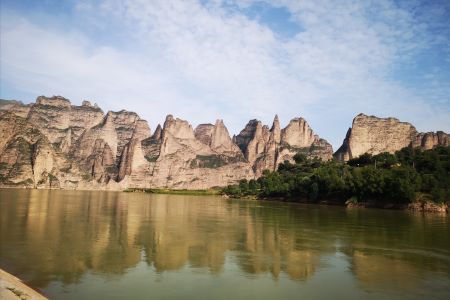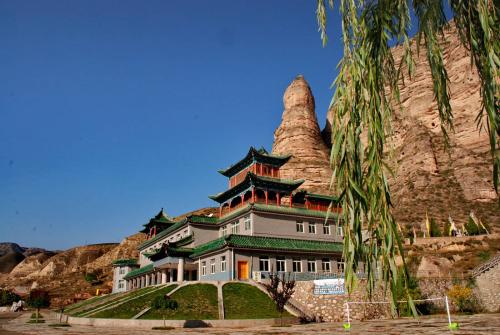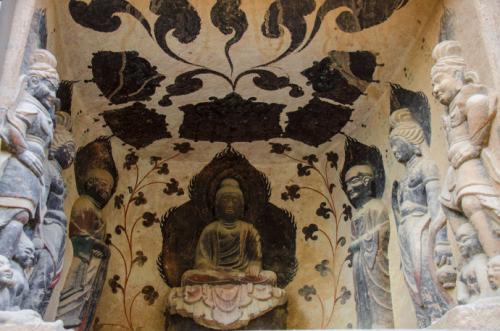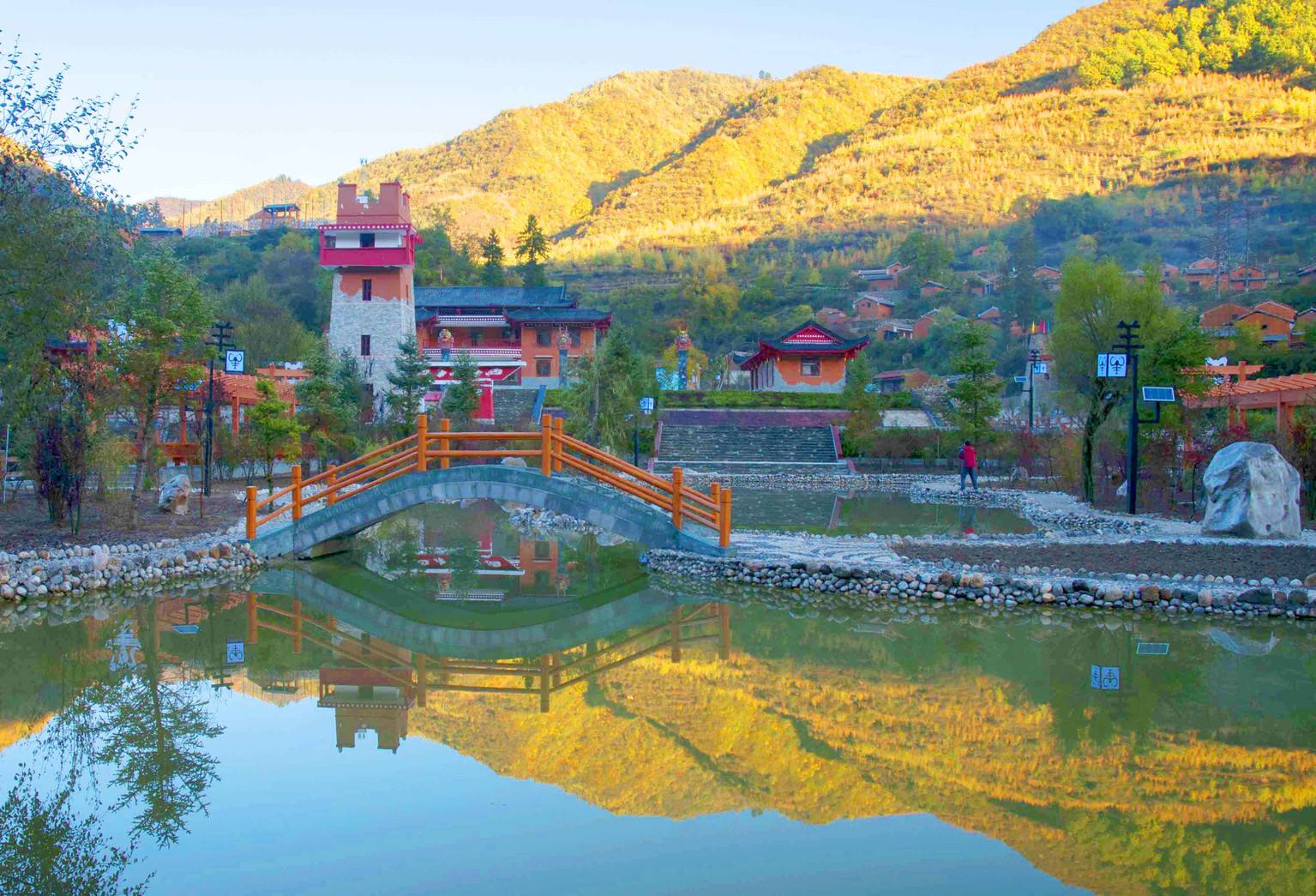Chinese Name: 炳灵寺 Pronunciation: Bǐng Líng Sì
English Name: Bingling Temple or Bingling Temple Grottoes
Building Time: 420
Best Visiting Time: All year round
Suggested Visiting Hour: 2-3 Hours
Opening Hours: 9:00-18:00(no entry after 16:00)
Address: Yongjing County, Linxia Hui Autonomous Prefecture, Gansu Province
| Admission Fee | 50 yuan |
| Extra Charge for Grottoes No. 169 and No. 172 | 300 yuan |

Bingling Temple is located on the west side of Jishi Mountain, about 40 kilometers southwest of Yongjing County, Linxia Hui Autonomous Prefecture, Gansu Province, China. One can reach there by taking a ferry from Liujiaxia. Although Jishi Mountain is located in the northwest plateau, the scenery is unique.
Bingling Temple Grottoes is on the right bank of the Yellow River, which is magnificent and embedded in the art pearl of Yellow River Canyon. The geological structure of Jishi Mountain where Bingling Temple is located is fine yellow sandstone, which is easy to be carved but not resistant to weathering and tide.
Owing to the dry climate of the region, the rock strata often protrudes like eaves and shields some Buddha grottoes from the wind, rain, and sun. Some of the Buddha grottoes have survived quite well through the ages.
Grottoes in Bingling Temple are relatively early works in the history of China’s grottoes excavation. Despite thousands of years, they are still full of artistic vitality and they are a treasure in the history of Chinese art.
After founding the People’s Republic of China, the State Council issued a notice officially proclaiming Bingling Temple as a national key cultural relics protection unit.
On June 22, 2014, the 38th UNESCO world heritage committee meeting was held in Doha, Qatar. On this forum, Bingling Temple in China was elected in the “World Heritage List” for the reason that Bingling Temple is a joint supportive point of “the Silk Road”, which linked Chang’an and Tianshan.
The different moments, times, and styles had made the Bingling Temple unfailing and worth visiting.

The historical origin of Bingling Temple has always been a holy place of Buddhism as well as Taoism since ancient times ( or a holy place of philosophy). The Western Qin Dynasty was established in 393-431 AD. Bingling Temple has the same pronunciation of the Tibetan language ‘ One Hundred Thousand Buddhas’ ( a saying that one hundred thousand Maitreya Buddhas appear for real).
Bingling Temple was first called “ Tangshuku” which means “ghost grotto” in the Qiang language. Later in the calendar, it was known as Longxing Temple (龙兴寺)and Lingyan Temple.(灵岩寺)After the reign of Yongle Emperor of the Ming Dynasty, the transliteration of the Tibetan “ Hundred Thousand Buddhas” was adopted and the name became “Bingling Temple”.
The Bingling Temple Grottoes were built in the first year of Jianhong in the Western Qin Dynasty(420 AD). From 420 AD to the Song Dynasty, the grottoes had a greater influence on Buddhism in the Han Dynasty.
In the Sui Dynasty, the place Bingling Temple was located was once a place where a prosperous merchant ship berthed. It was also the only place where the ancient “Silk Road” went south to Tubo, which is a Tibetan regime in ancient China. No matter what kind of statues and grottoes, they all describe the charming of the ancient dynasties respectively.

In modern China, Liujiaxia Reservoir began to store water in 1967, which posed a threat to the Bingling Temple Grottoes. Some of the grottoes could only be buried underwater. At that time, only 9 pieces of the 8.6-meter-long Reclining Buddhas in Grotto 16 were removed and preserved.
In order to protect the national treasure of art, Premier Zhou Enlai paid a lot of attention to arranging the construction of protection projects when the Liujiaxia Hydropower Station was impounding. Although the construction of the reservoir brought irreparable losses to Bingling Temple, it has also played a major role in developing the Yellow River and promoting local economic development.
Economic development and the integration of different cultures created the Bingling Temple. On the basis of inheriting the folk art of the previous generation, the Bingling Temple Grottoes absorbed and merged foreign Buddhist art, and created vivid sculpture images and painting art with a brand-new posture and concise technique.
There are currently 196 grotto niches distributed in Shangsi (上寺), Xiasi (下寺), Donggou (洞沟), Foyetai (佛爷台), and other places. They are also distributed on cliffs, which is 200 meters long and 60 meters high.

The largest sitting Maitreya Buddha of the Tang Dynasty is 27 meters high, and the smallest statue is 10cm high. Among them, 2 grottos and 1 niche were built in the Western Qin Dynasty, 8 grottos and 25 niches built in the Northern Wei Dynasty, 2 grottos built in the Northern Zhou Dynasty, 2 grottos built in the Sui Dynasty, and 20 grottos and 113 niches built in the Tang Dynasty.
The mainly grottos 169, 192 and 195 is in the Western Qin Dynasty. The Buddhist art style of the western regions is clearly reflected in the statues of this period.
The grottoes in Northern Wei Dynasty were mainly represented by grottos such as 126, 128 and 132 grottos, which fully reflected the Buddhist art style in Central Plains areas.
The artistic level of the Tang Dynasty was the highest when there were 3,000 monks in the temple.

It is a large grotto excavated during the Tang Dynasty with a flat square. The center of the grotto is connected with a stone tower on the top of the mountain. This stone tower is unique in China even the whole world with embossments at four sides.
The entire pagoda is composed of three parts: the base, the body and the top, which shows the architectural art of the Tang Dynasty.

It is a clay sculpture built in the Sui Dynasty. The Bodhisattva wears a flower crown on his head and has a relatively round and soft face and slim body. It has curved eyebrows, dropping eyes, thin lips, and a long skirt over his shoulders. One Bodhisattva statue of the Tang Dynasty has been destroyed.

Grotto No.169 is the largest, earliest and richest grotto in Bingling Temple Grottoes. It is the essence of Bingling Temple. Grotto No.169 is located above the Tang Dynasty Buddha at the north and as for the grottos, which are 50meters above the ground.
Grotto No.169 was originally a natural stone grotto. It is 26.75 meters wide, 15 meters high and 19 meters deep. There are 24 Buddhist niches in the grotto. The most representative Buddhist niches are the 6th and 7th niches.
The 6th niche is located on the north wall of the grotto. It is a flat, semicircular, three-petal lotus-like back screen niche.

Murals
In the painted bucket-shaped pavilion, the Feitian (an image of gods flying in the sky) is painted everywhere, especially the middle white part, which with light ink outlines. The whole body is nude and the god flies with his waist bowing, flying around the lotus petals. The statues at this time have the beauty of the Northern Wei Dynasty and the mellow beauty of the Tang Dynasty, which has a link between the two dynasties.
Owing to the differences in every scenic spot, it is supposed that going to Bingling Temple from Liujiaxia is recommended.
The one- way distance by boat is 54 kilometers, and the round-trip speedboat costs 120 yuan, which takes one hour. The big ship’s price of round- trip is 50 yuan, which takes three hours.
Chinese: 请带我去炳灵寺。English: Please take me to Bingling Temple.
If you go to Bingling Temple from the Lanzhou Zhongchuan International airport, it takes about 2 hours and 50 minutes (280 yuan).
If you go to Bingling Temple from the Lanzhou West Train Station, it takes about 2 hours and 50minutes (260 yuan).
